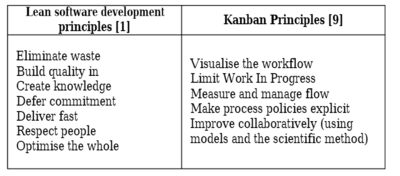Kanban in APPPM
(→Context) |
(→Kanban principles) |
||
| Line 32: | Line 32: | ||
== Kanban principles == | == Kanban principles == | ||
| − | |||
== Applications == | == Applications == | ||
Revision as of 21:29, 11 February 2021
'draft_ by Jesús Gracia Yoldi'
Contents |
Abstract
In any successful project, programme or portfolio, the weight of planning and management is vital to deal with the various types of complexities whether seen from technical, time, goal, social, organisational or legal perspectives. When establishing a complexity management plan to treat a time issue, the team should be under the guidance of a schedule, which allows clarification for issues such as when tasks have to be carried out. For this purpose, various methodologies are used, among them the Kanban methodology.
Kanban, translated to "visual cards" or "billboard" from Japanese, is a scheduling methodology in which you can maximise the productivity of a team by the optimisation of idle time of each process that results in the completion of a unit or project[1]. It was introduced in 1947, by Taiichi Ohno, who was an industrial engineer working for Toyota and father of the Toyota production system[1]. It was created to avoid waste, commonly known as Muda[2] in project management terminology, consequently increasing efficiency in product manufacturing chains. Kanban allows the team to visually target and remove bottlenecks, identified by avoiding these wastes, to reduce queuing times and increase throughput [2] . It was conceived in such a way that its use was directly related to Lean Manufacturing systems and the achievement of JIT (just-in-time) delivery approach.
This article will first provide an introduction and context to the concept of the Kanban methodology. This is followed by an explanation of its use and applications. Thirdly and finally, it will address its limitations, establishing its strengths and weaknesses.
Context
Origins
In its beginnings, Kanban emerged as a scheduling system, primarily for lean manufacturing. It was implemented in 1953 as a new approach in the Toyota Production System. The key distinguishing factor was that the principle was based on a pull system, meaning that production is driven by customer demand, as opposed to pushing systems in which production attempts to integrate products into the market.
The Kanban idea was originated from the observation of the product flow in supermarkets. The customer buys what is sufficient and necessary, knowing that his future supply is guaranteed. Consequently, the supermarket has in stock only what is expected to run out within a certain period. This phenomenon made it possible to extrapolate the idea from supermarkets to Toyota's production plants, making the following statements:[3]
- Anticipation:It implies de concept of demand- forecasting. Consists of aligning inventory according to the consumption of its products. Set up a signal with which to keep track of consumption, so that if it fluctuates, there is a margin for manoeuvre.
- Communication: Establish an inter-departmental communication system that allows cohesion of processes, to avoid misunderstandings. Every process needs a requirement to be able to perform its task. Once the task has been completed, one department hands over the card to the next, so that the other can start its own.
- Procurement: Any re-provisioning of resources between departments must be notified by handing over the cards.
Agile software developing teams in 2000s
Throughout the years, the Kanban methodology has remained a popular tool in production lines and is very common even today. Simultaneously, in 2004, the first case of Kanban being used in software development occurred. David J. Anderson noticed that a team of Microsoft professionals was not working optimally. [4]
The Kanban method in software brought a new perspective to visualise the workflow, in which all developers were able to identify bottlenecks within the process. This insight led to a reduction in the number of workstations, converting them into charts with notes attached to them.
Kanban principles
Applications
Limitations
References
- ↑ Rajat B. Wakode Laukik P. Raut Pravin Talmale (2015). Overview on Kanban Methodology and its Implementation . IJSRD - International Journal for Scientific Research & Development| Vol. 3, Issue 02, 2015 | ISSN (online): 2321-0613
- ↑ Hamzah Alaidaros. Mazni Omar. Rohaida Romli (2020). The state of art of agile Kanban method: Challenges and Opportunities . INDEPENDENT JOURNAL OF MANAGEMENT & PRODUCTION (IJM&P)http://www.ijmp.jor.brv. 12, n. 8, November-December 2021ISSN: 2236-269XDOI: 10.14807/ijmp.v12i8.1482
- ↑ Ohno Taiichi (1988) Toyota Production System: Beyond Large-Scale Production . Productivity Press. p. 176. ISBN 9780915299140.
- ↑ Ahmad, M. O., Markkula, J., & Oivo, M. (2013, September) Kanban in software development: A systematic literature review. In Software Engineering and Advanced Applications (SEAA), 2013 . 39th EUROMICRO Conference on (pp. 9-16). IEEE.
